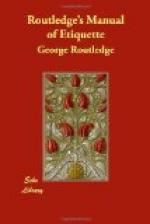The wedding should take place at the house of the bride’s parents or guardians. The parties who ought to be asked are the father and mother of the gentleman, the brothers and sisters (their wives and husbands also, if married), and indeed the immediate relations and favoured friends of both parties. Old family friends on the bride’s side should also receive invitations—the rationale or original intention of this wedding assemblage being to give publicity to the fact that the bride is leaving her paternal home with the consent and approbation of her parents.
On this occasion the bridegroom has the privilege of asking any friends he may choose to the wedding; but no friend has a right to feel affronted at not being invited, since, were all the friends on either side assembled, the wedding breakfast would be an inconveniently crowded reception, rather than an impressive ceremonial. It is, however, considered a matter of friendly attention on the part of those who cannot be invited, to be present at the ceremony in the church.
Who should be Bridesmaids.
The bridesmaids should include the unmarried sisters of the bride; but it is considered an anomaly for an elder sister to perform this function. The pleasing novelty for several years past, of an addition to the number of bridesmaids varying from two to eight, and sometimes more, has added greatly to the interest of weddings, the bride being thus enabled to diffuse a portion of her own happiness among the most intimate of her younger friends. One lady is always appointed principal bridesmaid, and has the bride in her charge; it is also her duty to take care that the other bridesmaids have the wedding favours in readiness. On the second bridesmaid devolves, with her principal, the duty of sending out the cards; and on the third bridesmaid, in conjunction with the remaining beauties of her choir, the onerous office of attending to certain ministrations and mysteries connected with the wedding cake.
Of the Bridegroomsmen.
It behoves a bridegroom to be exceedingly particular in the selection of the friends who, as groomsmen, are to be his companions and assistants on the occasion of his wedding. Their number is limited to that of the bridesmaids: one for each. It is unnecessary to add that very much of the social pleasure of the day will depend on their proper mating. Young and unmarried they must be, handsome they should be, good-humoured they cannot fail to be, well dressed they will of course take good care to be. Let the bridegroom diligently con over his circle of friends, and select the comeliest and the pleasantest fellows for his own train. The principal bridegroomsman, styled his “best man” has, for the day, the special charge of the bridegroom; and the last warning we would give him is, to take care that, when the bridegroom puts on his wedding waistcoat, he does not omit to put the wedding ring into the corner of the left-hand pocket. The dress of a groomsman should be light and elegant; a dress coat, formerly considered indispensable, is no longer adopted.




